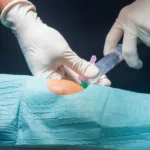

According to Sullivan et al. (2022), the study on physicians’ use of and preferences for FDA-approved Prescribing Information (PI) revealed a preference for clarity and specificity in drug labeling. This study emphasizes PI’s significance in providing enhanced communication of drug information to healthcare providers.
Prescribing information can help providers understand the entire product and treatment procedure to ensure a safe and effective process for each patient. Learning about Synvisc prescribing information can allow medical professionals to optimize patients’ knee osteoarthritis relief and increase their quality of life.
This article will explore the Synvisc prescribing information, its indications, precautions, and potential adverse events.
Key Takeaways
- Synvisc injections require direct administration into the affected knee joint, leading to adequate lubrication and shock absorber for the joints.
- The US Food and Drug Administration has approved Synvisc injections to treat patients with knee osteoarthritis.
- The Synvisc dosing regimen requires one injection of the solution in the affected knee joint once a week for three weeks.
- While Synvisc is generally safe for most individuals, healthcare providers must remember specific contraindications of the viscosupplement.
- Follow-up appointments with providers can help monitor the patient’s treatment response, adjust necessary Synvisc or Synvisc One dosage and frequency, and suggest repeat treatments if possible.
- While patients can expect temporary side effects after their Synvisc injections, rare occurrences of adverse reactions can also be associated with intra-articular injections.
About: Medica Depot is your trusted all-in-one supplier, offering a range of high-quality medical injectables and supplies. If you’re looking to order Synvisc online, you can do so on Medica Depot quickly and easily. We offer a worry-free experience in searching for the best and most popular products on the market. Whether for health professionals, plastic surgeons, dermatologists, licensed estheticians, or other specialists, we can offer genuine, brand-name products you may need. With Medica Depot, we prioritize serving you better to improve the patient’s quality of life.
What is Synvisc?
Synvisc is a brand name for a type of hyaluronic acid (HA) injection directly administered into the joint, also known as viscosupplementation. HA is a natural substance found in the body’s joints, making it a safe treatment for knee osteoarthritis (OA).
This injection therapy requires direct administration into the affected knee joint, leading to adequate lubrication and shock absorber for the joints. So, what is Synvisc used for? Viscosupplementation treatment, like Synvisc, works similarly by supplementing the lost HA into the joint’s synovial fluid. It helps reduce pain and improve joint mobility.
Indications for Use

Medical professionals must study and understand Synvisc prescribing information to know the appropriate indications and injection techniques for viscosupplement. The recommended instructions can ensure patients receive safe and effective Synvisc treatment.
- Approved Indications for Synvisc: The US Food and Drug Administration has approved Synvisc injections to treat patients with knee osteoarthritis (OA). Moreover, medical professionals can only recommend Synvisc to patients who have not responded to other conservative therapies or simple analgesics.
Patients with early to severe knee OA can benefit from this injection treatment, as well as those who are not candidates for total knee replacement surgeries. However, individuals need to undergo a thorough consultation with their trusted healthcare provider. This can help providers create a tailored treatment plan to align Synvisc with patients’ preferences.
- Dosage and Administration: The Synvisc dosing regimen requires one injection of 2 mL solution in the affected knee once a week for three weeks. The typical injection days are 1, 8, and 15, while Synvisc One dosage only needs a complete 6 mL single injection for each knee.
Synvisc Injection’s Contraindications
While Synvisc is generally safe for most individuals, healthcare providers must remember specific contraindications of the viscosupplement. These contraindications can aid in a secure treatment procedure and avoid further health complications.
- Do not administer to patients with known hypersensitivity or allergy to hyaluronan (sodium hyaluronate) preparations.
- Do not inject Synvisc in the knees of patients having knee joint infections, skin diseases, or infections in the area of the injection site.
Furthermore, healthcare providers should also consider other conditions that may influence the safety and efficacy of Synvisc injections. Remembering these can avoid potential risks and complications for patients.
- Synvisc derived its hyaluronic acid from chicken combs, which may cause allergic reactions in patients with allergies to avian proteins, feathers, egg products, etc. Providers should not continue the use if patients have known hypersensitivity to these products.
- While Synvisc does not explicitly mention specific precautions for patients with bleeding disorders, this could potentially lead to bleeding complications. Discussing this with your trusted doctor before proceeding or discontinuing the procedure is crucial.
It’s worth noting that the Synvisc manufacturer has yet to establish the safety and effectiveness of Synvisc injections for special populations. It’s best to avoid giving these injections to the following individuals to prevent possible risks.
- Pregnant Women
- Breastfeeding Women
- Children under 21 years old
Precautions When Using Synvisc

The Synvisc prescribing information offers numerous general precautions when using Synvisc injections. Understanding these precautions can help maintain the integrity, safety, and efficacy of the viscosupplement product.
- Synvisc manufacturer has yet to establish the safety and effectiveness of Synvisc in locations other than the knee and for conditions other than osteoarthritis.
- Medical professionals should use the syringe’s contents immediately after opening its packaging.
- Do not use Synvisc if the package is opened or damaged.
- Store in original packaging (protected from light) at room temperature below 86°F (30°C) and avoid freezing the injection.
- Healthcare providers should remove synovial fluid or effusion before each Synvisc injection.
- Synvisc should be used with caution when there is evidence of lymphatic or venous stasis in the leg to be injected.
After Synvisc injections, medical professionals may advise patients to avoid strenuous or knee-stressing activities for 48 hours post-injection. Applying ice briefly or resting the knee can minimize Synvisc side effects, such as pain or swelling at the injection site. When side effects persist, seek medical attention.
Moreover, follow-up appointments with providers can help monitor the patient’s treatment response, adjust necessary Synvisc or Synvisc One dosage and frequency, and suggest repeat treatments if possible. So far, providers have not reported any known drug interactions with Synvisc.
Nonetheless, patients should still inform their providers of all their medication intake to allow them to align the product to the patient’s needs.
Adverse Reactions


While patients can expect temporary side effects after their Synvisc injections, rare occurrences of adverse reactions can also be associated with intra-articular injections. These reactions can range from mild to severe and may require medical attention to avoid further complications. The reported common adverse reactions include:
- Pain in the injected knee
- Swelling in the injected knee
- Joint effusion
In addition, serious adverse events may occur, and patients may need immediate medical help. Medical professionals can efficiently manage these symptoms, which could happen rarely.
- Arthralgia
- Joint stiffness
- Joint effusion
- Joint swelling
- Joint warmth
- Injection site pain
- Arthritis
- Arthropathy
- Gait disturbance
When patients experience adverse events, they must report them to their healthcare providers or the US Food and Drug Administration (FDA). Detailed information can help the FDA investigate the event and the product.
Conclusion
Synvisc is a viscosupplement that capitalizes on high molecular weight hyaluronic acid injections, administered directly into the knee joint. The US FDA indicates Synvisc for treating knee osteoarthritis (OA) patients who have not responded adequately to first-line therapies.
Medical professionals should understand the Synvisc prescribing information to ensure a safe patient procedure, considering the contraindications, precautions, and potential risks of adverse events. Following the proper administration techniques allows optimal symptomatic relief outcomes for knee OA patients.
FAQs
1. What is Synvisc used for?
Synvisc is a brand name for a hyaluronic acid (HA) injection directly administered into the joint to treat knee osteoarthritis. It helps to supplement the lost HA into the joint’s synovial fluid, reducing pain and improving joint mobility.
2. Who can use Synvisc injections?
The US Food and Drug Administration approves Synvisc injections to treat patients with knee osteoarthritis who have not responded to other conservative therapies or simple analgesics. Individuals with early to severe knee OA can benefit from this injection treatment, as well as those who are not candidates for total knee replacement surgeries.
3. What are the contraindications of Synvisc?
Some contraindications of Synvisc injections include known hypersensitivity or allergy to hyaluronan preparations, knee joint infections, skin diseases, or infections in the area of the injection site. Patients with allergies to avian proteins, feathers, and egg products, among others, should also avoid Synvisc.
References
- Sullivan, H. W., Squire, C., Aikin, K. J., Tzeng, J., Ferriola-Bruckenstein, K., Brodsky, E., Trentacosti, A. M., & Johnson, M. (2022). Physicians’ use of and preferences for FDA-approved prescribing information. Research in social & administrative pharmacy: RSAP, 18(6), 3027–3037. https://doi.org/10.1016/j.sapharm.2021.07.028
- SYNVISC ® HYLAN G-F 20. (n.d.). In Sanofi US. https://products.sanofi.us/synvisc/synvisc.pdf
Aesthetic supplies USA refers to products and equipment used in the field of aesthetic medicine and cosmetic treatments that are available for purchase in the United States. These supplies encompass a wide range of items necessary for various aesthetic procedures and treatments conducted by professionals such as dermatologists, plastic surgeons, aestheticians, and other qualified practitioners.
Examples of aesthetic supplies include:
-
Dermal Fillers: Injectable substances used to restore volume and reduce wrinkles.
-
Botulinum Toxin (Botox): Injectables used to temporarily relax facial muscles and reduce wrinkles.
-
Laser Devices: Equipment used for hair removal, skin rejuvenation, tattoo removal, and other laser treatments.
-
Chemical Peels: Solutions applied to the skin to exfoliate and improve texture.
-
Microdermabrasion Devices: Tools used for mechanical exfoliation to rejuvenate skin.
-
Microneedling Devices: Devices that create tiny punctures in the skin to stimulate collagen production.
-
Cosmeceuticals: Skincare products that contain biologically active ingredients with pharmaceutical-like benefits.
-
Sterilization and Disinfection Products: Essential for maintaining hygiene and preventing infections in clinical settings.



